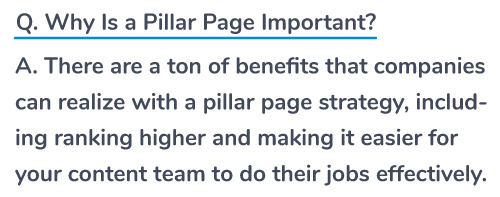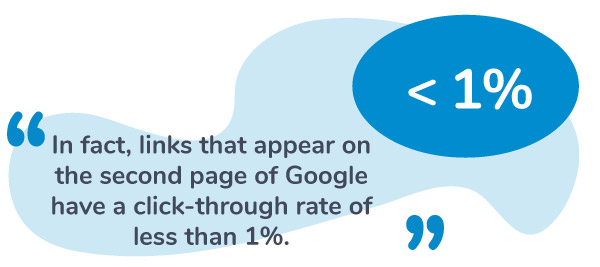Benefits of Pillar Pages: A Guide to the Do's and Don'ts
February 18, 2022 •Shannon Elward

If Google brought you here, chances are you’re searching for some information about pillars, and we don’t mean the ones that are a part of Greek and Roman architecture—although they’re similar in a sense. After all, a pillar page is designed to be an authoritative page of a website, holding up and supporting smaller blog posts about the same topic.
But what exactly are pillar pages, and why have they become so important over the past few years? We’re exploring all of this and more—including how our own SEO pillar page about content marketing got 91 first page results on Google in just five short months. Keep reading to find out more!
What Is a Pillar Page?
First things first: a pillar page is a part of an SEO strategy built around a particular content or topic cluster (or a group of topics and keywords that all revolve around one central point). In this strategy, a pillar serves as the highest-level, most in-depth resource about a given topic, covering everything you need to know in about 3,000 words. The pillar would be posted on a web page—also called a pillar page— that contains a sidebar with links to additional support pillars and blogs (other pieces of content that go into detail about subpoints of the pillar topic).
Breaking that down, topic clusters examples might include “furniture repair,” “steak,” or “content marketing.” Then, you’d use your topic clusters to develop additional, more detailed pieces of content around your pillar topic. Using those same examples, perhaps you’d write about “upholstery repair,” “grilling kebobs,” or “keyword research.”
Looking for content pillar examples? At DemandJump, we believe in pillar pages so much that we’ve developed several of our own. You can check out our content marketing pillar page to start—we’ll try to get to work on those furniture repair and steak pillars later.
Why Is a Pillar Page Important?
So you’ve got an idea of what a pillar page is. But does the strategy really work, and why’s it so important, anyway? At the risk of providing a spoiler, yes, it absolutely works! There are a ton of benefits that companies can realize with a pillar page strategy, including ranking higher and making it easier for your content team to do their jobs more effectively. Curious? Let’s dive into some of the benefits.

Rank Higher
The fact is, pillar pages speak the same language Google and other search engines speak. No, we’re not talking about coding or programming; we’re talking about the algorithm. When it comes to determining rankings, Google appreciates being able to quickly understand what kinds of content a website has, an internal linking strategy (which a pillar strategy has), and well-organized content. All of these are pillar page best practices designed to enhance your SEO value and search engine results page (SERP) rankings.
Need proof? Our own content marketing pillar earned 221 top 100 Google rankings and 18 first page rankings in just 45 days. Five months in results showed 91 first page Google results!
Get a Bigger Audience
Better Google rankings mean more people will see your content. Full stop. And that, in turn, can lead to more conversions, more customers, and more revenue. Why? When we search for things online, most of us don’t go past the first page on Google. In fact, links that appear on the second page of Google have a click-through rate of less than 1%. Compare that with the first organic result, which has a click-through rate of about 28.5% according to Search Engine Journal.

Pillar pages provide better SEO value and higher SERP rankings. All of that, in turn, gives you a better likelihood of ranking on the first page. And that’s where all the magic happens.
Create Better Content
Any marketer will tell you that one of the struggles with organic content marketing is figuring out what to write about day in and day out. Pillar pages and their associated strategy help take the guesswork out of content marketing. By taking a content cluster and deciding on an overarching topic (like furniture repair), you’re left with a nearly limitless amount of related topics that you can support pillars and blogs around. There’s “upholstery repair,” “replacing a couch leg,” “replacing cushions,” “refinishing a table”… You get the idea. There are even tools like DemandJump that’ll help you generate these topics!
A pillar page strategy creates a unified topic to build articles around, giving your content team a roadmap to run with. As an added bonus: once they’re all written, the use of interlinking between posts and an on-page sidebar creates great pillar page SEO value. It’s truly a win-win.
DemandJump: Data-Driven Pillar Pages Made Easy
If you’re in marketing, you know the SEO game is changing, and pillar pages are the best way to rank better now. DemandJump is designed by marketers, for marketers to help companies create content strategies to increase their first-page rankings and drive better outcomes. With DemandJump, you can instantly access what content to create and one-click outlines to aid in the writing process.
Ready to try it out for yourself? Try us free today.
Featured Articles
Categories
- Attribution Tracking (13)
- Channel Optimization (11)
- Consumer Insights (68)
- Content Marketing (251)
- Data Science (8)
- Digital Marketing (6)
- Digital Transformation (26)
- Enterprise (10)
- Lead Generation (14)
- Market Intelligence (8)
- Marketing Analytics (39)
- Marketing Attribution (57)
- Marketing Management (153)
- Marketing Operations (86)
- Organic Search (222)
- Paid Search (52)
- Pillar-Based Marketing (63)
- Programmatic Advertising (9)
- SaaS Content (14)
- SaaS Marketing (29)
- Search Marketing (111)
- SEO Keyword Research (28)
- SEO Pillar (18)
- SEO Strategy (46)
- SMB (5)
- Website Content (12)


